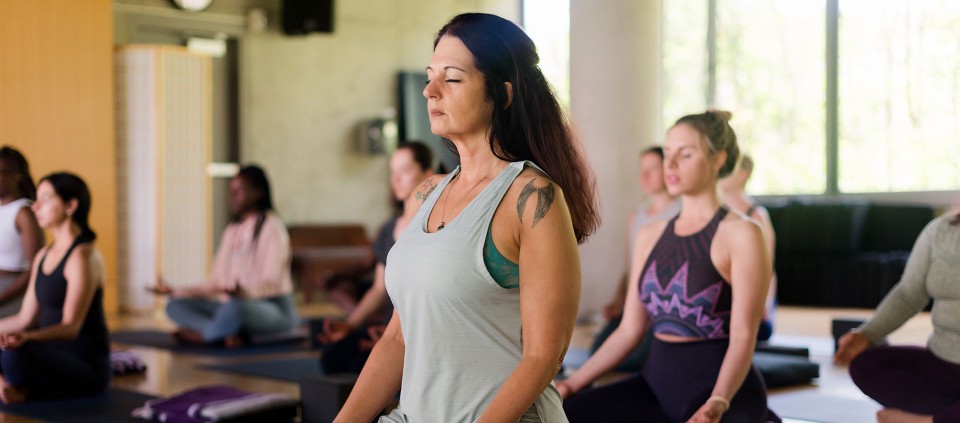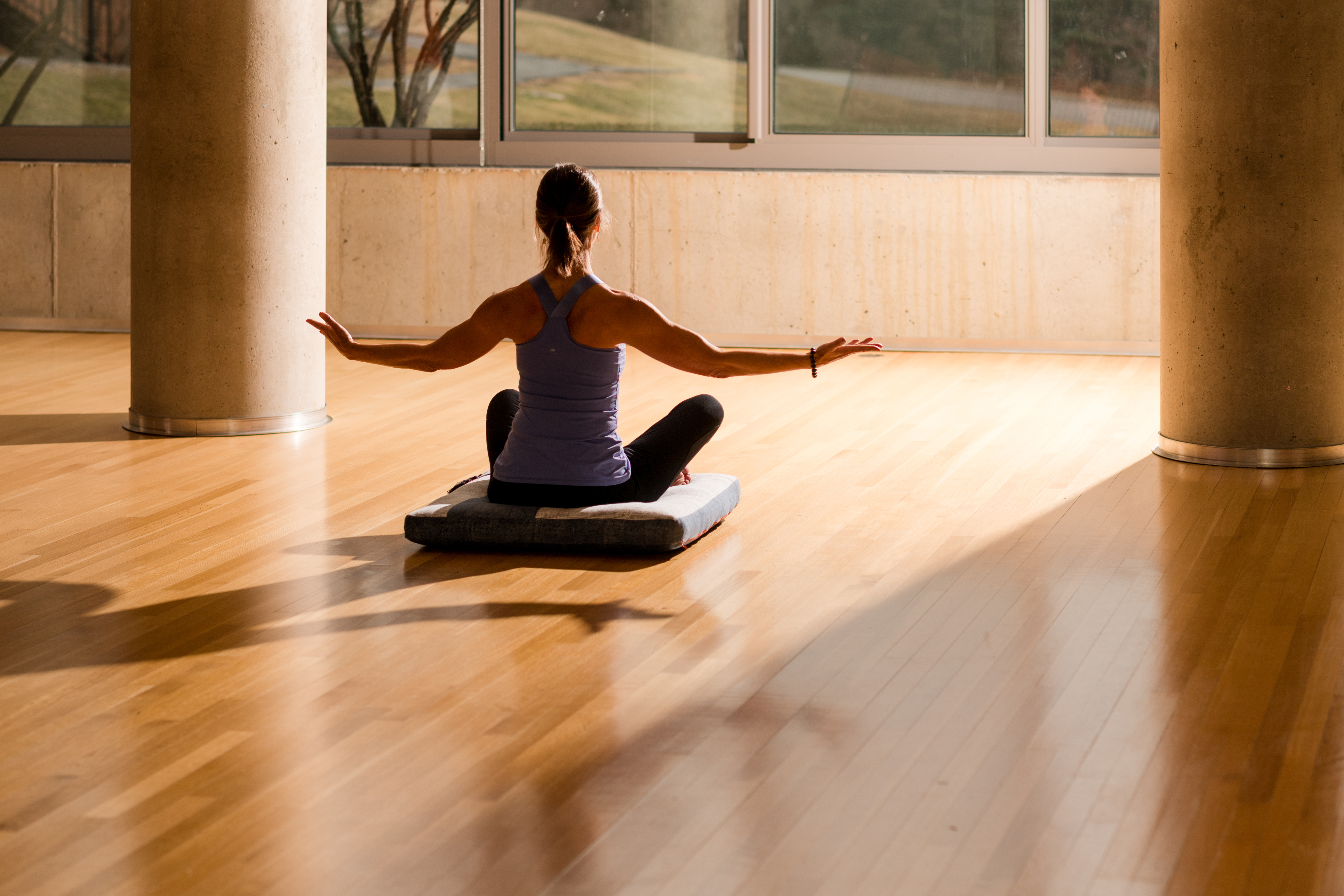Yoga for Menopause

Given our modern healthcare and longer life spans, women in America can anticipate spending close to one-third of their lives in a post-reproductive state. Instead of seeing menopause as the end of fertility and the beginning of aging, let’s view it through the lens of yoga and see menopause as a life transition and a transformative experience.
Each woman’s menopause is like a fingerprint—unique and personal. And the way she perceives and moves through this transition can transform her inner and outer experience.
One way to view menopause as a life transition is through the ashramas, the four stages of life, a concept found in Hindu philosophy. Originally intended for men, a contemporary interpretation provides guidance for women. The four stages are
- Student: (or child) learns about one’s role in society
- Householder: (adult) raises a family and/or makes a contribution to society through relationships, work, or volunteer efforts
- Forest Dweller: (mid-life) begins the preparatory work for personal or spiritual realization
- Renunciate: (senior years) may decide to turn these years into a focused opportunity for spiritual wisdom and enlightenment.
In general, the Forest Dweller stage seems perfectly timed for menopause, which can be seen as moving away from a more active (rajasic) time of life toward a more contemplative (sattvic) one. Many Western writers and thinkers, such as Marian VanEyke McCain, Christiane Northrup, and Clarissa Pinkola Estes, support this yogic view of the female life span. They point to the drive that moves women to begin an inner journey, address unfinished business, and claim the wisdom and power inherent at this time of life. Seen from this perspective, menopause is a natural transition that can deepen the yoga journey.
However, as lovely and spiritual as that sounds, there are challenges women may face. While doing research for my master’s thesis on menopause, I discovered a long list of possible symptoms including the most common:
- Hot flashes and flushes
- Night sweats
- Fuzzy thinking
- Mood swings
- Weight gain.
And two uncommon ones:
- Formication (a feeling of “ants crawling all over the body”)
- Frozen shoulder.
How Yoga Can Help
A consistent practice of yoga modified for individual needs and abilities can help women recognize, accept, integrate, and transform the menopause experience and the intense feelings of stress that may accompany it. Here’s one woman’s story of how menopause and stress intersect:
P., a yoga teacher and friend, told me she had a lot going on in her life: menopause, a new husband, a 12-year-old daughter from a former marriage, a toddler from the new marriage, a stressful job as a researcher for a domestic violence project, a new yoga business, and a pending appearance as a witness in a sexual harassment suit. Usually efficient and punctual, she was experiencing growing periods of mental fuzziness. In addition, she had been losing track of time, not showing up for some appointments and being late for others. She was experiencing what for her was an uncomfortable level of inner turmoil. “I don’t really think I have more stress than usual,” she said. “It’s just that I feel it more now.”
Yoga postures, breath practices, and meditation are effective methods of stress management. As a yoga therapist, I recommend that anyone dealing with stress from menopause (or any source), find ways to incorporate a well-rounded yoga practice into their lives. Adapting a practice for menopause will depend on the needs of each woman. For example, when doing Sun Salutations, moving through postures slowly, taking time to sense and feel the body in each posture, is cooling and calming. Moving faster with more repetitions will warm and energize. This practice is easily adapted to accommodate all levels of ability, and can be done on the mat or in a chair.
Managing Hot Flashes
Managing individual symptoms is another matter. In her book, The Wisdom of Menopause, Christiane Northrup, MD, defines a hot flash this way: “Also known as vasomotor flushing, the hot flash occurs when the blood vessels in the skin of the head and neck open more widely than usual, allowing more blood to shift into the area, creating heat and redness.”
Typically triggered by falling estrogen levels, hot flashes usually stop a year or two after the actual menopause date. However, in some cases women may experience hot flashes for years. M., another friend of mine, was surprised and appalled to be experiencing hot flashes a decade after her last period. When I told her that it was normal, although understandably uncomfortable, she said, “Why didn’t my doctor ever tell me that?” I’m guessing that her doctor did not know.
In general, if a woman has an adverse response to stressful events, she may have more hot flashes, or she may experience them more intensely. Conversely, the more effectively a woman handles stress, the more likely she is to experience milder hot flashes or have less intense reactions to them. This can be true of other menopause symptoms as well.
Women who are experiencing hot flashes have a variety of cooling, calming yoga practices to choose from. Here is one of my favorites.
Cooling Breath for Hot Flashes
The Cooling Breath is a modified version of Sheetali pranayama, and can be done anytime, anywhere. The inhalation brings cool air into the body, while the exhalation releases warm air.
It helps to practice the Cooling Breath consistently so it will be readily available when a flash or a flush is coming on, and it will often stop one as it begins. This pranayama has helped several of my yoga students and a few others, including M., my flashing friend, who does not have a yoga practice and is not interested in starting one.
- Sit (or stand) with a comfortably aligned spine.
- Purse your lips as if you were going to whistle.
- Slowly draw air over the tongue and deep into the lungs.
- Close your mouth and exhale slowly through your nose.
- Repeat as many times as you like and as often as needed.
- You can also practice the Cooling Breath in bed if you have hot flashes during the night.
As you begin to think about how you view menopause, keep these words from anthropologist Margaret Mead in mind: “There is no more creative force in the world than the menopausal woman with zest.”
Beth Gibbs, MA, E-RYT 500, C-IAYT, is a yoga therapist certified through Integrative Yoga Therapy (IYT) and is a guest faculty member of the Kripalu School of Integrative Yoga Therapy.
Full Bio and Programs